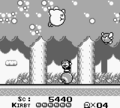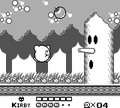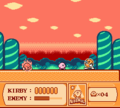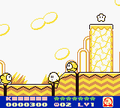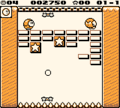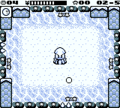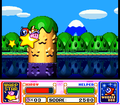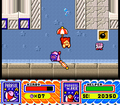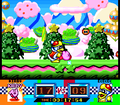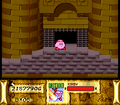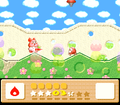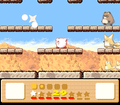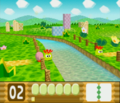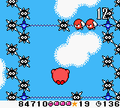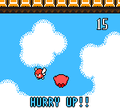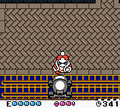Heads-up display
A Heads-up display (often abbreviated to HUD) is a feature in most video games wherein visual information is presented during gameplay which is not present in-universe that allows the player to keep track of various things, including a player character's life, the score, the number of lives remaining, time elapsed and/or remaining, and other information depending on the game. Each Kirby game has an HUD of some kind, though most games have a unique visual manner of presenting the information, in addition to changing what appears on-screen depending on gameplay circumstances and/or the game mode being played. For the sake of simplicity, this page will only discuss HUD elements in the main games of each Kirby title unless otherwise noted.
HUD by game
Kirby's Dream Land
In Kirby's Dream Land, the HUD is a white space at the bottom of the screen where the following information is shown:
- Score (shown as Sc:) - total points that the player has earned during the session.
- Stamina (shown as Kirby:) - how much stamina Kirby has remaining, represented as a meter containing up to six bars.
- Extra lives (represented with a small Kirby icon next to a number) - how many extra lives the player has left.
When a Mid-Boss or Boss appears on the screen, the score counter is overridden with a new display represented with a menacing-looking face along with a new meter which represents the stamina of the foe in question. Notably, this enemy health bar looks different to Kirby's, being more square and contiguous.
An enemy health bar overrides the score display when Kirby fights a boss or mid-boss; in this case Whispy Woods.
Kirby's Adventure
In Kirby's Adventure, the player is given a more elaborately-decorated HUD, shown in an orange box at the bottom of the screen. The following information is shown there:
- Stamina (shown as Kirby:) - how much stamina Kirby has remaining, represented as a meter containing up to six bars.
- Score - total points that the player has earned in the game.
- Status panel - New to Kirby's Adventure is a small box containing an illustration along with some text inset. This panel will usually display which Copy Ability Kirby has if any, but will also change if Kirby takes damage, jumps into a cannon, clears a stage, or for other things.
- Extra lives (represented with a small Kirby icon next to a number) - how many extra lives the player has left.
As before, when a Mid-Boss or Boss appears, the score display is replaced by an enemy health bar, though this one takes on a much different appearance, consisting of many tiny bars in sequence with multiple usually being removed whenever the enemy takes a hit.
The HUD as it appears in normal gameplay, here showing that Kirby has the UFO ability.
The enemy health bar appears during Boss fights, in this case versus Mr. Shine & Mr. Bright.
Kirby's Pinball Land
Kirby's Pinball Land has its HUD scattered around the screen, occupying each corner save for the upper-right. The information displayed is as follows:
- Extra lives - represented as distinct icons of Kirby's face, they occupy the upper-left, and accumulate or disappear to represent the amount, with eight being the maximum display number.
- Score - shown in the lower-left, this is the player's total score for the session.
- Bonus - shown in the lower-right, this is how many additional points are going to be awarded to the player after losing a life, represented by two numbers to be multiplied.
- Time - shown only during the mini-games, a timer appears in the lower-left above the bonus counter which starts at 60 seconds and counts down to 0.
Unlike previous games, enemy health is not shown during boss fights.
A section of gameplay in the mini-game of Wispy-Woods Land, showing all HUD elements.
Kirby's Dream Course
Kirby's Dream Course features a fairly complicated set of HUD elements, though not all of them are present at any one time. During gameplay, the HUD defaults to a bar near the bottom of the screen, which has the following information, from left to right:
- An illustration typically used to show which Copy Ability Kirby has, but it will display other images too based on the circumstances.
- The player's signature image, made during the name entry screen.
- The current hole being played, ranging from 1 to 8.
- The current shot being taken.
- Kirby's stamina, represented by up to four "Energy Tomatoes".
- The number of lives remaining.
When making a move, this bar may mostly disappear at certain moments so as to not obscure the player's view of the proceedings, leaving only the left-most status image. When using the camera to view the board, arrows will appear at the edges of the screen to indicate that the player can keep panning in that direction. When lining up Kirby's spin or shot power, a separate panel appears which has a representation of Kirby along with arrows and meters with which to make the adjustments. Lastly, the 2P Game features a distinct HUD which removes most extraneous information, electing to keep only the statuses of both Kirby and Keeby, their stamina (now represented as more traditional health bars) and the current score of each player.
Template:KAv KGT
Due to its nature as a Puyo Puyo puzzle game, [[Kirby's Avalanche|Template:KAv KGT]] is framed entirely around its HUD elements. At any given time during gameplay, the following information is shown:
- Score - displayed in the lower-left for the player and the lower-right for the opponent. The total score is momentarily replaced with a multiplier when blobs are being removed, which is later added to the total.
- Next - shown in the upper-middle, this shows what the next sets of blobs will be for both the player and the opponent.
- The current stage is displayed in the middle of the board for the single player game.
- In the lower-middle, a representation of Kirby is shown which displays his reaction to the game's proceedings, though this is purely cosmetic in nature.
In Template:KAv KGT, the HUD surrounds two windows, the left of which shows the player's blobs, and the right of which shows the opponent's blobs.
Kirby's Dream Land 2
Kirby's Dream Land 2 features a HUD similar to that of Kirby's Dream Land, but with a few additions. The HUD displays the following information:
- Stamina (demarcated with the letter K) - how much stamina Kirby or his Animal Friend has remaining, represented as a meter containing up to six bars.
- Score - total points that the player has earned in the game, shown below the health bar.
- A star meter is displayed in the upper-middle of the HUD, which fills up as Kirby collects Small Stars. Once the meter fills completely, the player gains a 1-Up and it resets to empty.
- Extra lives (represented with a small Kirby icon next to a number) - how many extra lives the player has left.
- LV - displayed next to the extra lives counter, this shows which level Kirby is currently in, ranging from 1 to 7.
- An illustration on the right-most side of the bar shows the player which Copy Ability Kirby has, if any.
Like before, when a boss or mid-boss appears, the score display is overridden with the boss's health bar, denoted with the letter "E".
Kirby's Block Ball
In Kirby's Block Ball, a space is left at the top of the screen for the HUD. The following information is presented there:
- Extra lives - represented as a Kirby icon next to a number, this shows how many lives the player has remaining.
- Status - just below the lives counter, a small portrait can be seen which shows Kirby's current status, particularly which Copy Ability he may have.
- Score - a number representing the total score the player has accumulated for the stage.
- Star count - a number next to a small star; this shows how many star blocks Kirby has obtained during the "Target Shooting" rounds prior to the boss fights.
- Stage and round - furthest right, the stage and round Kirby is currently in are displayed in number form (example: 01-1 is Stage 1, Round 1).
As usual, the score is overridden by an enemy health bar during boss fights.
Template:KSS KFP
Given that there are six main game modes in [[Kirby Super Star|Template:KSS KFP]], each one has its own distinct HUD, at least visually speaking. All of the HUDs have the following information in common, where applicable:
- Extra lives - the number of lives the player has remaining, represented by a number next to a small Kirby icon.
- Stamina - the amount of HP Kirby has remaining (now represented by a continuous meter, rather than in bars).
- Kirby's status - similar in function to Kirby's Adventure, this shows what Copy Ability Kirby has, as well as other things.
- Helper stamina - when a Helper is in the game, a separate life bar appears for it, usually in green as opposed to Kirby's red.
- Helper status - a portrait of the Helper will appear along with the life bar when the Helper is in play.
- Enemy stamina - shows when a Mid-Boss or Boss is on screen, and overlaps the score in some cases.
In addition, the following game modes have the following additional HUD elements:
- Spring Breeze, Dyna Blade, and Milky Way Wishes - a score is displayed which increments as enemies are defeated.
- Gourmet Race - a score for Kirby and King Dedede is shown, showing how much food points each has accrued in the race. Additionally, a timer is shown at the bottom which counts up until the race ends.
- The Great Cave Offensive - a score for Kirby is shown, represented by the "total value" of all the treasure he has collected in "G"s.
- Revenge of Meta Knight - a timer displays in the center of the HUD which constantly ticks down. If the timer reaches 0, Kirby is automatically defeated. In addition, a space for the Helper's portrait and "Vital" is always shown, even if there is no Helper at play. Lastly, when characters have dialogue, it overlaps the HUD bar.
- Milky Way Wishes - to the right of the HUD bar, the name of the planet Kirby is currently trekking through is always shown.
- The Arena - a special HUD is used which removes extraneous information other than Kirby's status and stamina, and prominently features the opponent's stamina. If a Helper is summoned, its icon appears on the same side as Kirby's.
The HUD in Spring Breeze while Kirby and a Helper are riding a Warp Star
Kirby's Star Stacker (Game Boy)
There are four main modes to play in Kirby's Star Stacker for Game Boy, though all of them share the same basic HUD, with only minor differences in display. Each game mode has the following HUD elements in common all displayed on the right side of the screen:
- A representation of Kirby appears in the lowermost portion, who dances about in various ways depending on how the game is going.
- A preview of the next block set that will drop appears near the top of the bar.
Specific game modes have the following differences:
- Round Clear - a portrait of King Dedede appears which has various reactions based on how the game is going. Beneath the King Dedede portrait is a number representing the number of stars Kirby still needs to stack. Up at the top, the round and difficulty is shown in the form of a number for the former and an expression of Kirby representing the latter.
- VS - A portrait of Kirby appears at the top representing the difficulty. In the middle, a star icon appears, along with an indicator to show when the player or the opponent is about to be given more rows of blocks.
- Challenge - A portrait of Kirby appears at the top representing the difficulty. In the middle, Mr. Star can be seen, along with a score representing the number of stars Kirby has stacked.
- Time Attack - A timer appears along the top, counting down from 3 minutes. In the middle, Tick-Tock Jr. can be seen, along with a score representing the number of stars Kirby has stacked.
Each game mode also has minor decorative differences for the HUD.
Kirby's Dream Land 3
Kirby's Dream Land 3 features an HUD bar in the lower portion of the screen, much like previous main-series Kirby games. This bar has a wood-grain theme and displays the following information:
- On the left side, a white box can be seen which is blank when Kirby has no ability, but will feature an icon representing any copy ability Kirby has when he acquires one. Another such box is visible on the right side, which represents Gooey's ability.
- Along the upper-middle of the HUD are five small blocks representing Kirby's health, which shrink in size to represent half-increments. When Gooey is out, one of the yellow blocks is removed to make room for four blue blocks on the right side to represent Gooey's health.
- In the middle of the HUD is a number that represents the number of extra lives the player has.
- Surrounding the extra lives counter are six star-shaped icons which represent the number of Star Pieces Kirby has collected. Each star icon fills up in fifths, and when all are fully filled, a 1-Up is given to Kirby and the icons reset.
- The bottom portion of the HUD is reserved for boss and mid-boss health meters, and is empty when neither are present.
Notably, Kirby's Dream Land 3 is the first main-series game to not have a score display as part of its HUD.
Kirby's Star Stacker (SNES)
Kirby's Star Stacker for Super Famicom has a similar set of HUD elements to its Game Boy predecessor, but the elements of it are spread out over a wider and more decorated screen due to the increased graphical capabilities of the new system. There are a few notable differences to mention, as follows:
- Round Clear now has Kirby and King Dedede standing on opposite sides of the game board on star platforms, and the number of stars Kirby needs to stack is now represented as Dedede's "HP".
- VS and Story Mode now feature two boards simultaneously on screen: One for Kirby, and one for his opponent. Likewise, the next block preview shows for both screens.
- Story Mode features the two combatting characters standing next to each-other, jumping when a new row of blocks appears, and hitting each-other to make rows appear on the opponents' board. The number of new rows set to appear is represented as stacks of medals underneath the respective characters. Story Mode also features an in-game timer for the whole set of rounds, though this can only be seen when using an inputted player name, as opposed to the "guest" account.
- KSSS Lovely match.jpg
Screenshot from one of the Story Mode matches against Lovely, showing two simultaneous boards and the characters "battling" each-other to make things happen in the boards.
Kirby 64: The Crystal Shards
Kirby 64: The Crystal Shards features a simplified HUD bar that occupies the lower portion of the screen at all times during regular gameplay. It bears a similar style to that of Kirby's Dream Land 3, and displays the following information:
- The left side features a box that displays how many extra lives the player has in number form.
- The upper-middle of the bar has six "eggs" which show how much health Kirby has.
- The lower-middle of the bar is a meter in thirty sections which shows how many Point Stars Kirby has collected. Once the meter fills, it resets and a 1-Up is awarded. During mid-boss and boss fights, this meter is overridden by the enemy health bar, which displays in red.
- The right side of the bar has two white panels, which can contain Kirby's copy ability. When both are filled with icons, Kirby has acquired a Power Combo.
In this game, the player has the option to change the look of the HUD bar to one of five different settings, as follows:
- The default wooden look
- A blue whiteboard-like look
- A knitted red floral-design look
- A crayon-drawn look
- A black and blocky digital look
In the Japanese version, the fourth option is replaced with a display showing traditional Kanji symbols in place of the regular numbers and ability icons.
Kirby Tilt 'n' Tumble
Kirby Tilt 'n' Tumble has an HUD similar to that of classic Game Boy Kirby games, though with a bit of a different layout:
- The left end of the bar features the score. During boss fights, this is replaced with the enemy health bar.
- The middle features Kirby's health, as a line of three pink blocks that can increase or decrease in half-increments. During boss fights, this health bar can increase up to five blocks.
- Right of the health bar is the point star counter, which is removed during boss fights to make room for Kirby's potentially increased health.
- Right-most is the timer, which counts down continually during gameplay, and defeats Kirby if it reaches 0.
Time is a major feature of the HUD for Kirby Tilt 'n' Tumble, with both the regular timer at the bottom-right, as well as an extraneous counter for things like the Balloon transformation, seen in the upper-right.
Kirby: Nightmare in Dream Land
Kirby: Nightmare in Dream Land is the first main line Kirby game to ditch an HUD bar in favTemplate:Or of just having various displays hovering over the screen without a backdrop. Despite this, the same information is displayed to the player as in Kirby's Adventure, though the status image is not always visible. In Meta Knightmare, the score is replaced with an incremental in-game timer.
- VV Stage 1 start NinDL.png
When Kirby is without an ability, the only HUD elements visible are his health, the 1-Up counter, and the score display.
- Vegetable Valley Stage 2 NinDL screenshot.png
When Kirby gains a copy ability, a small illustration briefly pops up in the lower-left corner, then shrinks down to merely the name of the ability with a black backdrop.
In Meta Knightmare, the 1-Up counter is modified to resemble Meta Knight, and the score display is replaced with an incremental timer.
Kirby Air Ride
Kirby Air Ride is a much different case than any of its predecessors due to being in an entirely different genre (racing as opposed to action/platforming or puzzle). As with Kirby: Nightmare in Dream Land, its HUD elements hover over the main screen rather than being confined to a bar or something similar. Each game mode in Kirby Air Ride features a different set of HUD elements, though there are similarities, particularly between Air Ride and City Trial.
Air Ride
During standard gameplay in Air Ride mode, the following HUD elements can be counted on:
- The upper-left shows a circle containing a number which indicates the player's current placing in the race, which can range from 1st to 4th. During the Free Run and Time Attack modes, this circle is not present, since there are no opposing racers.
- The upper-middle shows the timer, which increments in minutes, seconds, and centiseconds during the race. This is the main indicator of the player's performance in Time Attack and Free Run.
- Between the placing icon and the timer, icons representing enemies and the other racers will appear in boxes briefly if the player lands an attack on that enemy/racer.
- In the upper right, a small minimap can be seen showing the broad layout of the course and the player's position on it, along with the positions of the other racers where applicable.
- Beneath the minimap is a fractional indicator showing the player's current lap on the left and the total number of laps on the right.
- In the lower-right is the player's Charge gauge and speedometer. The speedometer displays miles per hour (mph) in the North American versions of the game and kilometers per hour (kph) in other regions, showing the speed to a precision of two decimal points. The Charge meter surrounds the speedometer on both sides, and gradually fills up as the player builds charge, either by braking or gliding. The meter then releases that charge to give the player a boost when those actions end. Lastly, when the racer has a status effect (such as Kirby gaining a Copy Ability), a special illustrative effect is added to the mix to represent this.
There are a large number of additional HUD elements that can appear based on circumstances and game mode, as follows:
- When playing with more than one player, the game has to split the screen in various ways and add/alter various HUD elements. In two-player mode, the screen splits horizontally, additional indicators are added in the lower-left to denote whose screen is whose (P1 for player 1) which is also colTemplate:Ored to match the player's colTemplate:Or, and the minimap is replaced with a progress bar in-between the screens. In three-player mode, the screen is split into three equally-sized rectangular portions, with the fourth space being blank, and the minimap going there. In four-player mode, this last blank area is given to player 4, and the progress meter is once again used in place of a map. Other HUD elements (aside from the timer), have to be copied, simplified, and given to each player's screen.
- During Time Attack and Free Run, after completing a lap for the first time, a text display will appear in the lower-left which shows the player's current/best times for the lap(s).
- If playing with "Damage" enabled in the options, an HP bar appears on the right side of the screen, which forces the player to retire if it becomes depleted.
- When playing on "Time" mode, rather than "Laps" mode, the timer is set to count down from a specified amount instead of up, and the race ends upon running out of time. The laps counter is replaced with a number that measures distance raced (in feet for North America and meters elsewhere), and having the highest distance at the end of the race is the goal.
- Certain Copy Abilities, such as Plasma and Bomb, have additional meters that appear when using the ability, to indicate the relative strength or distance of the attack.
Top Ride
Due to its simplified nature, Top Ride features many less HUD elements than the other two racing modes. Its overhead view and small courses also mean that there are no splitscreen considerations to be made, as a single camera is all that is needed to keep track of all four racers. The HUD elements of Top Ride are as follows:
- The upper-middle shows the timer, which increments in minutes, seconds, and centiseconds during the race. This is the main indicator of the player's performance in Time Attack and Free Run.
- Along the bottom, up to four counters are shown which belong to each racer, showing their relative placings and the current lap they are on.
- The lower-right shows a circle containing a number which indicates the total number of laps needed to complete the race.
City Trial
City Trial features largely the same HUD elements as Air Ride mode, with the following exceptions:
- The placing icon and laps counter are removed due to being irrelevant in the open city.
- The HP meter is present by default, and can grow or shrink in length depending on how much HP Kirby's machine has.
- A large complicated map of the city appears in the lower-left which shows players' relative positions. In four-player splitscreen, this map is not available.
- The timer is set to count down by default, with the city portion ending when time runs out. (The timer increments during Free Run mode.)
- During certain events, a compass appears that directs the player to the location of the event, also giving them a distance measure to their target.
Certain Stadium events also have their own HUD elements. For more information about those, check the various Stadium match pages.
- NebulaBelt Mahn.jpg
During a race in Air Ride mode with standard settings, the player has access to a number of different bits of info via the HUD, including their current speed, time, placing, and position on the map.
- TopRide Grass.jpg
In Top Ride mode, a speedometer is eschewed in favTemplate:Or of showing all the players' relative placings along the bottom, and a map is no longer necessary due to the small size of the courses.
- CityTrial Picture.jpg
The HUD during City Trial is largely the same as that for Air Ride, though an HP meter is added by default and the map is moved to a different location. The placing and laps indicators are also naturally ditched due to being irrelevant here.
Kirby & The Amazing Mirror
Due to being directly based on the engine for Kirby: Nightmare in Dream Land, Kirby & The Amazing Mirror has largely the same HUD style and many of the same elements. There are a few crucial differences, however, which are as follows:
- Kirby's health meter has been altered, giving him thinner bars that match his current colTemplate:Or. This health meter can be expanded by finding Vitality hearts.
- In the lower-right, the score counter has been replaced with a set of text that tells the player which area they are in.
- In the upper-left, a small Cell Phone icon with an energy meter in three pieces shows the player how much battery power Kirby's cell phone still has.
- Next to the battery meter, icons representing the other Kirbys and which abilities they have show up when those Kirbys are not in the same area.
